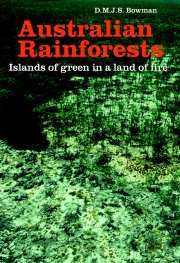Book contents
- Frontmatter
- Contents
- Preface
- 1 Introduction
- 2 What is Australian rainforest?
- 3 The sclerophyll problem
- 4 The edaphic theory I. The control of rainforest by soil phosphorus
- 5 The edaphic theory II. Soil types, drainage, and fertility
- 6 The climate theory I. Water stress
- 7 The climate theory II. Light and temperature
- 8 The fire theory I. Field evidence
- 9 The fire theory II. Fire, nutrient cycling, and topography
- 10 The fire theory III. Fire frequency, succession, and ecological drift
- 11 The fire theory IV. Aboriginal landscape burning
- 12 The fire theory V. Aridity and the evolution of flammable forests
- 13 The fire theory VI. Fire management and rainforest conservation
- 14 Summary
- References
- Index
6 - The climate theory I. Water stress
Published online by Cambridge University Press: 23 November 2009
- Frontmatter
- Contents
- Preface
- 1 Introduction
- 2 What is Australian rainforest?
- 3 The sclerophyll problem
- 4 The edaphic theory I. The control of rainforest by soil phosphorus
- 5 The edaphic theory II. Soil types, drainage, and fertility
- 6 The climate theory I. Water stress
- 7 The climate theory II. Light and temperature
- 8 The fire theory I. Field evidence
- 9 The fire theory II. Fire, nutrient cycling, and topography
- 10 The fire theory III. Fire frequency, succession, and ecological drift
- 11 The fire theory IV. Aboriginal landscape burning
- 12 The fire theory V. Aridity and the evolution of flammable forests
- 13 The fire theory VI. Fire management and rainforest conservation
- 14 Summary
- References
- Index
Summary
Schimper's (1903) original use of the term ‘rainforest’ succinctly encapsulated his belief that luxuriant, Xoristically and structurally complex tropical vegetation could only develop in a drought-free climate. Although some Australian ecologists have adhered to the idea that moisture supply is of critical importance in controlling the distribution of Australian rainforest (Specht 1981a), there are several features of Australian rainforests that are inconsistent with this theory. Firstly, there is an imperfect correlation between high rainfall areas and the distribution of rainforest, a fact that puzzled pioneering ecologists such as McLuckie and Petrie (1927). Secondly, in the latter half of this century many Australian ecologists broadened the concept of rainforest to include vegetation that occurs in low rainfall and seasonally dry climates (Webb 1959; Baur 1968; Webb and Tracey 1981; Adam1992) (Figure 6.1). This broadening of definition is reflected in the use of the oxymoron ‘dry rainforest’ (Baur 1957; Adam 1992; Fensham1995). Indeed, many authors have opted to spell rainforest as a single word (rather than the more conventional ‘rain forest’) in order to play down the implication that high rainfall is critical in controlling the distribution of rainforest in Australia (Baur 1968; Webb and Tracey 1981; Adam1992). Thirdly, there is evidence that some Australian rainforest trees, including some that occur in high rainfall environments, are extremely drought tolerant, being able to endure seasonal moisture deficits with ‘leaf water potentials more commonly associated with arid environments’ (Yates et al. 1988).
- Type
- Chapter
- Information
- Australian RainforestsIslands of Green in a Land of Fire, pp. 99 - 133Publisher: Cambridge University PressPrint publication year: 2000



